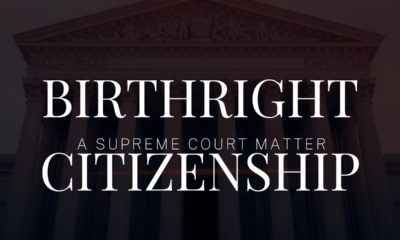Constitution
Kansas amendment fails
The Kansas amendment on regulation of ending of pregnancy failed by a large margin, because it was ambiguous in wording and apparent purpose.
Voters in Kansas refused to amend their Constitution to nullify a three-year-old Kansas Supreme Court decision. As a result, women in Kansas may still end their pregnancies, at least up to 22 weeks. Already the spin doctors are hard at work. A few moments of sober reflection will show what proponents of the Kansas amendment did wrong. They’ll also show the real cue those who value human life must take.
The Kansas amendment and its motive
The amendment to the Kansas constitution, that would have allowed its legislature to regulate pregnancy ending more tightly, read thus:
§ 22. Regulation of abortion. Because Kansans value both women and children, the constitution of the State of Kansas does not require government funding of abortion and does not create or secure a right to abortion. To the extent permitted by the constitution of the United States, the people, through their elected representatives, and state senators, may pass laws regulating abortion, including, but not limited to, laws that account for circumstances of pregnancy resulting from rape or incest, or circumstances of necessity to save the life of the mother.

As Erick-Woods Erickson pointed out, many voters likely found that wording ambiguous, and its intentions far from clear.
The actual impetus for the Kansas amendment was a Roe-like ruling in 2019 from the Supreme Court of Kansas. In Hodes and Nauser v. Derek Schmidt, the court held:
Section 1 of the Kansas Constitution Bill of Rights affords protection of the right of personal autonomy, which includes the ability to control one’s own body, to assert bodily integrity, and to exercise self-determination. This right allows a woman to make her own decisions regarding her body, health, family formation, and family life—decisions that can include whether to continue a pregnancy.
Hodes and Nauser were gynecologists challenging a law forbidding a second-trimester procedure called dilatation and evacuation. That procedure involves dismemberment of the unborn child.
Failure – and the likely reasons
The Kansas amendment, which supporters called Value Them Both, failed of passage, 60 percent to 40 percent. Proponents of the amendment merely said they would “be back” to try again. But opponents breathlessly declared this meant that Kansans celebrated what they called “fundamental rights.”
The very complaint some of them made against the Kansas amendment, belies that last claim. They said the wording was ambiguous – and it certainly is. It talks a great deal about what the Kansas constitution does not permit. But the second sentence seems to imply a loosening of restrictions, not a tightening of them. For that reason, Mr. Erickson guessed that many pro-life voters voted against it because they thought this amendment would be a disaster for their position. And he is very likely correct.
Erickson also predicted that the Mainstream Media would make too much of this result. First, he says, Kansas voters tend to stay “in the middle of the road.” Second, Republicans cast 60 percent of all the primary votes.
The Kansas Reflector reported a higher urban vote, and a lower rural vote, than in the Election of 2020.
What should be next after the Kansas amendment
This failure recalls the first time someone tried to amend away a bad decision by a Supreme Court. During the 98th Congress, Senator Jake Garn (R-Utah) proposed a Human Life Amendment (SJR 4). It would have said flatly:
With respect to the right to life, the word “person,” as used in this Article and in the Fifth and Fourteenth articles of amendment to the Constitution of the United States, applies to all human beings, irrespective of age, health, function, or condition of dependency, including their unborn offspring at every stage of their biological development.
No unborn person shall be deprived of life by any person: Provided, however, that nothing in this article shall prohibit a law permitting only those medical procedures required to prevent the death of the mother.
That amendment didn’t even muster two-thirds of both Houses of Congress. But at least it defined that word person in crystal-clear language.
Contrast that with the Kansas amendment. It tries to duplicate the result in Dobbs v. Jackson Women’s Health Organization. The Hodes Court (for lack of a better term) would have to search elsewhere than in Section 1 of the Constitution of Kansas to invalidate this. But they could use one of the Bill of Attainder clauses, specifically Article I, Section 10, Clause 1. They could say that this section declares women to be outlaws, subject to a special penalty. Recall Barack Obama’s articulation of the anti-life position:
Why should she be punished with a baby?
Define the right to life explicitly!
The problem for right-to-life people in Kansas is that ending a pregnancy is not an all-or-nothing proposition in Kansas today. Current law and regulation in Kansas:
- Restricts pregnancy ending after the 22nd week,
- Requires notification of the parents of any minor seeking to end her pregnancy, and
- Requires the observance of a waiting period.
Regulations like these reflect what the Casey precedent allowed. Of course, Casey is no more.
But in order to protect human life properly, one must define an explicit right to it. This the Kansas amendment would not have done.
The Value Them Both coalition chose to use ambiguous language, perhaps in an attempt to sound reasonable. Those who stand for the truth should not play that kind of game. You don’t stand for the truth by lying – or dissembling.
The urban-rural spread on this vote tells us that Value Them Both grew complacent on one, possibly two counts. They grew complacent in assuming:
- a favorable and reliable state of election integrity in Kansas (which remains in sharp dispute), and
- that they actually had the hearts and minds of enough people in Kansas.
They were wrong on the second count and maybe also on the first.
Winning hearts and minds
We now come to a worse problem. Hearts in Kansas would appear to be still hard, and minds closed. That described political feeling in 1973, and even ten years later when Jake Garn proposed his own amendment. (And not only Jake Garn but Henry Hyde, the National Right to Life Committee, and many others.)
The right-to-life side had to learn patience. So they patiently sought to convince people that:
- The very act of ending a pregnancy was wrong, and furthermore
- The typical methods for ending a pregnancy sullied the medical profession and coarsened society in general.
Ironically, the anti-life side might have eroded the foundation of their own position. They didn’t keep their children. Pro-life people kept theirs. Thus the second and third generations of voters included ever more voters raised in pro-life homes. These voters elected Donald J. Trump, who critically replaced Justices Anthony Kennedy and especially Ruth Bader Ginsburg. Their replacements gave us the Dobbs decision. (And the Carson and Kennedy decisions.)
But Kansas is where the country was in Jake Garn’s day. And Dobbs is incomplete. Dobbs specifically avoids making any universal moral judgments.
That’s why the pro-life side must argue on behalf of the unborn. They must argue in the court of public opinion, and in “real” courts. Imagine a case like Unborn Child X v. Hodes and Nauser. And they must press that kind of argument, as long as it takes. And not with the ambiguity we saw with the failed Kansas amendment.
Terry A. Hurlbut has been a student of politics, philosophy, and science for more than 35 years. He is a graduate of Yale College and has served as a physician-level laboratory administrator in a 250-bed community hospital. He also is a serious student of the Bible, is conversant in its two primary original languages, and has followed the creation-science movement closely since 1993.
-

 Civilization2 days ago
Civilization2 days agoDC Pipe Bomb Arrest Raises Questions About Christopher’s Wray’s FBI
-

 Guest Columns4 days ago
Guest Columns4 days agoCongressional Leaders See Far Higher Stock Returns Than Peers
-

 Civilization3 days ago
Civilization3 days agoThe Legal Logic Behind U.S. Operations Against Narco-Terrorist Networks
-

 Civilization4 days ago
Civilization4 days agoHow Trump Changed America
-

 Executive3 days ago
Executive3 days agoNewsom’s ‘National Model’ for Homeless Wracked by Fraud
-

 Executive2 days ago
Executive2 days agoWhen You’re in a Hole, Stop Digging
-

 Education2 days ago
Education2 days agoWaste of the Day: Taxpayers Subsidize Football Coach Severance
-

 Civilization1 day ago
Civilization1 day agoPence Calls on Trump To Fire RFK Jr Over Abortion Drug












